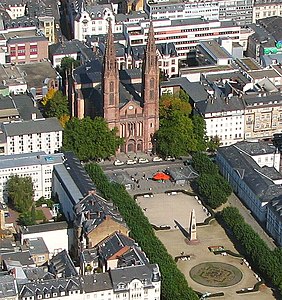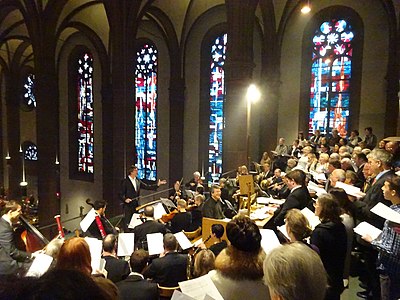St. Bonifatius, Wiesbaden
History
The first church St. Bonifatius

As Wiesbaden was Protestant after the Reformation, the first Catholic parish after the Reformation was founded in 1800. The congregation first met in a Bethaus (oratory) in the Marktstraße. It soon became too small for the growing number of Catholics in the town, which prospered as a spa and Residenz of Nassau. The parish received grounds adjacent to the Luisenplatz from the Duke of Nassau, and from 1829 to 1831 Friedrich Ludwig Schrumpf built a rigidly Neoclassical church, in keeping with the buildings around the square. Soon after the building was completed, it collapsed on 11 February 1831. A likely reason is insufficient foundation on ground which had previously been ponds.
The second church St. Bonifatius
On 24 May 1843, the young Philipp Hoffmann received the commission to build a church. He had already participated in building the town castle. His design is reminiscent of Gothic architecture, but also includes elements of Romanesque architecture and naturalistic ornaments to be found later in the Jugendstil. The foundation was laid on the day of the patron saint St. Bonifatius, on 5 June 1845. The interior was consecrated by the Bishop of Limburg Peter Josef Blum on 19 June 1849. A rib vault is supported by 22 columns. The facade was completed in 1856, and the towers in 1866.
In World War II the church suffered severe damage. An air raid on 2 February 1945 destroyed all the windows, the roof, and part of the vault. Repairs made in 1949 replaced the vault with a simple construction. The vault was re-built in a general restoration in 1965, which also took into account the changes of the Second Vatican Council. A new altar by Elmar Hillebrand was added in 1967. The new windows are stained glass in mainly white, red and blue, designed by Johannes Beeck. Sculptor Karl Hoffmann created a crucifixion scene and a sculpture of both St. Francis and Teresa of Ávila.
Church music

An organ was built in 1954 by Orgelbau Romanus Seifert & Sohn. In 1985 the instrument was expanded by Hugo Mayer Orgelbau; in 1995 three electronic bass stops were added. The Kantor was Gabriel Dessauer from 1981, the conductor of the 120-member Chor von St. Bonifatius, founded in 1862, the children's choir Kinderchor von St. Bonifatius, and the Schola for Gregorian chant. He was succeeded by Roman Twardy. The church choir sings at services, including regular orchestral masses of Haydn, Mozart, Beethoven and Schubert for Christmas and Easter. Every year, typically on 3 October, a choral concert is performed. Other annual features are choral and organ concerts organised around a theme, called Boni-Musikwochen, including concerts of organists such as Kent Tritle and Ignace Michiels, and the project choir Reger-Chor. On 7 November 2015, as part of the 21st festival Wiesbadener Bachwochen, the church presented a concert dedicated to French church music, Gabriel Fauré's Cantique de Jean Racine and Requiem and Olivier Latry's Salve Regina. A project choir of 150 singers performed, led by three conductors of the Diocese of Limburg, with soloists and members of the orchestra of the Hessisches Staatstheater Wiesbaden.
Dessauer ended conducting the choir in 2019, succeeded by interim conductor Roman Twardy. His term as church musician ended with 2021. He was succeeded by Johannes Schröder.
Priests
The priests of St. Bonifatius were at the same time Stadtdekan (dean) of Wiesbaden, including:
- Joseph Weyland (1863–1887)
- Antonius Hilfrich (1927–1930)
- Georg Rompel (1954–1968)
- Werner Bardenhewer (1974–1996)
- Ernst-Ewald Roth (1996–2006)
- Johannes zu Eltz (2006–2010)
- Wolfgang Rösch (2010–2013)
- Klaus Nebel (from 2015)
Chaplains
- Lothar Zenetti (1926–2019)
Literature
Gottfried Kiesow: Architekturführer Wiesbaden – Durch die Stadt des Historismus, 2006, ISBN 3-936942-71-4, pp. 75 (in German)
Gallery
-
Aerial view of the Luisenplatz
-
Ground plan
-
The church from the west
-
Interior from the organ loft
-
Christmas 2018
-
Dvořák's Stabat Mater, 2019
-
Oratorio de Noël, 2022
References
- ^ Detlef Gottwald (2008). "Kirche St. Bonifatius" (in German). Wiesbaden. Archived from the original on 4 September 2011. Retrieved 10 December 2010.
- ^ Gottfried Kiesow: Das verkannte Jahrhundert. Der Historismus am Beispiel Wiesbaden, Deutsche Stiftung Denkmalschutz, 2005, ISBN 3-936942-53-6, p. 128 (in German)
- ^ "Historicism / Bonifatiuskirche". Wiesbaden. 2010. Retrieved 10 December 2010.
- ^ Kösterke, Doris (9 November 2015). "150 Chorsänger erarbeiten an einem Tag Aufführung zweier Kompositionen von Gabriel Fauré". Wiesbadener Kurier (in German). Retrieved 9 November 2015.
- ^ Reichwein, Barbara (17 August 2021). "Johannes Schröder wechselt nach Wiesbaden / Der junge Musiker ist der Nachfolger von Gabriel Dessauer an der St. Bonifatius-Kirche" (in German). Diocese of Limburg. Retrieved 9 October 2021.
External links
- St. Bonifatius, Wiesbaden website (in German)
- "St. Bonifatius, Stadtlexikon". Landeshauptstadt Wiesbaden (in German). Retrieved 12 December 2022.
- "St. Bonifatius". Landeshauptstadt Wiesbaden (in German). Retrieved 12 December 2022.






